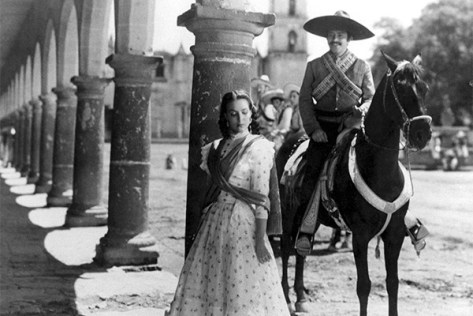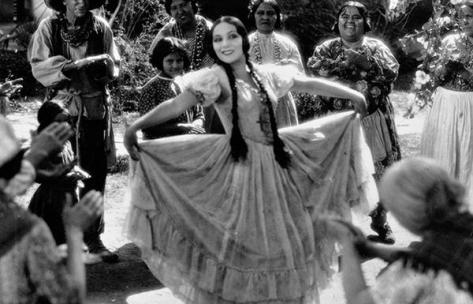This is a guest post for Silent London by Amran Vance, who runs the London Silent Film Meetup group and is part of the team behind the wonderful Kennington Bioscope.
When I wrote about the inaugural Nitrate Picture Show at the George Eastman Museum, Rochester, New York, last year I ended with the slightly pessimistic hope that we would get to see a silent film on nitrate next time around. My fear was that shrinkage issues with such old prints might prevent that from happening. I am delighted to report that my cynicism was misplaced as this year’s festival ended on a sensational high, an American silent film from 1928! But more about that later.
As with last year, the festival organisers kept the 2016 programme under wraps until the morning of the first day of the festival. I know this approach is controversial. Potential attendees have complained to me that they are reluctant to incur the not inconsiderable expense in traveling to upstate New York when they have no idea what films will be screened. I have a lot of sympathy with that view but there is something undeniably exciting about opening the brochure on the first day and seeing what treats lie ahead of us. There is also merit in the organisers’ position that it is the physical condition and pictorial beauty of the prints that governs their selection, with the quality and reputation of the works coming next. Personally, I favour a middle ground, perhaps naming three or four films in advance and keeping the rest secret.

I suspect that few, if any,who made the journey to Rochester were disappointed with the films presented to us. I was initially sorry to see that no silents were listed but was keeping my fingers crossed that the final screening of the festival, our Blind Date with Nitrate, might possibly fulfill that wish. And so it did.
The festival kicked off with a selection of short films – my favourites were a colorful Julius Pischewer animation Cent Ans de Chemins de fer Suisses celebrating 100 years of the Swiss railway system and a delightful 1934 Universal animation Jolly Little Elves featuring doughnut-loving kindly elves.
These were followed by one of the highlights of the festival and a film I had not seen before, Enamorada (1946) a tempestuous romantic drama set against the background of the Mexican revolution. Featuring the masterful framing of the legendary cinematographer, Gabriel Figueroa, the film looked gorgeous, especially the exterior shots of the Mexican town in which the story is set. María Félix, probably Mexico’s most famous actress, was beguiling as the feisty female lead and Figueroa makes masterful use of light and shade, given added depth and texture by the nitrate print.

Our final film on the first day was the classic noir, Laura, which we were told was a pre-release version that included footage that was cut for its theatrical distribution. Nobody I spoke to could spot the additional material, however, and although the print was good there were only moments when the benefit of nitrate showed through.
Nor did I feel that there was very much of the “Nitrate Touch” in the opening film of the second day, Annie Get Your Gun (1950) but what a joyous romp of a film it is. The film was new to me, although many of the splendid Irving Berlin songs, were not, including There’s No Business Like Show Business and Anything You Can Do. Betty Hutton played the role of Annie Oakley with inexhaustible gusto and it was a thoroughly enjoyable start to the day.
Events took a more serious turn with the second film, the Boulting brothers’ wonderful Brighton Rock (1947) in which Richard Attenborough delivers his deliciously sinister performance as Pinkie, the murderous gangland leader. This film definitely benefited from being seen on nitrate, especially in the film’s climactic moments on Brighton Pier where the interplay of light and shadow was given extra intensity.
The print of Bicycle Thieves (1948), Vittorio De Sica’s neo-realist masterpiece, was somewhat muddy (I was told by someone more knowledgeable than me that it looked dupey) but it is always a pleasure, if an anguished one, to see the film, even though I always conjure up an alternative ending in my own mind.
The penultimate show of the second day was another shorts programme featuring two gorgeous Oskar Fischinger animations, An Optical Poem (1937) and Allegretto (1936). The print of Allegretto was stunning with colours so vivid they looked as if they were in 3D. You can watch An Optical Poem below but, sadly, it looks washed out compared to the nitrate copy we were fortunate enough to see.
The musical theme continued with the closing film of the second day, the sumptuous visual feast that is Powell and Pressburger’s The Tales of Hoffmann (1951). I saw the recent restoration of the film on DCP last year, which was wonderful, but even better was seeing this nitrate print (although the last reel was acetate). The colours and textures of the outfits looked exquisite in three-strip Technicolor. Moira Shearer’s performance in the Dragonfly pas de deux prologue had me mesmerised from the start.
We began the third and final day of the festival in eager anticipation of the closing film, our “Blind Date with Nitrate”. Phil Carli had been spotted! Could he be accompanying a silent in the last slot of the show? But then, as he lives in Rochester, and had been attending all three days of the festival ,we couldn’t really read anything into that one way or the other.

Before the final secret was revealed we had two other delights lined up for us. The first was a lovely print of Road House (1948) a noir starring Ida Lupino in sultry form as a sassy, no-nonsense night club singer caught up in a love triangle with Cornel Wilde and an increasingly psychotic Richard Widmark, in what was almost a reprise of his role in Kiss of Death a few years earlier. Lupino has some razor-sharp lines; her enjoyable performances, as well as Widmark’s, made this a hugely satisfying first film of the day.
It was followed by a screening of Martin Scorsese’s personal print of Blithe Spirit (1945) David Lean’s film version of Noel Coward’s play starring Rex Harrison as the quintessential upper-class English gentleman . Harrison is splendid but, for me, Margaret Rutherford steals the show as Madame Arcati, the eccentric medium who conjures up the spirit of Harrison’s dead wife much to the displeasure of his current one. The film deservedly won plaudits for its special effects and the print looked vibrant and fresh.
And so to our Blind Date … A couple of minutes before the film was due to start I was chatting to Phil Carli who was sitting in an aisle seat nearby. I mentioned how disappointed I was to see him seated there rather than by the piano at the front of the auditorium which had its lid closed and with no sign at all of any imminent use. Phil, with a completely straight poker face, empathised but gave no clue at all as to what was about to unfold.

As the lights went down and the curtain rose, I looked to my left and saw Phil still seated there. Oh well, “that’s that”, I said to my companion. Then as it got darker I thought I saw a flurry of activity by the piano. Was that someone bringing out a piano stool? It was now so dark that I couldn’t see if Phil was still in his seat. The audience waited with bated breath for what seemed like an eternity. When the title screen appeared there was a gasp of approval and enthusiastic applause. It was a silent! Dolores del Rio in Edwin Carewe’s 1928 film Ramona. And there was Phil at the piano.
The film had been thought lost for decades until a complete print was identified in 2010 at the Národní film archive in Prague and shipped to the United States, where its English titles were reconstructed from the Czech intertiles. That was the version that I saw at the Pordenone Silent Film Festival last year. But we were about to see a nitrate print. How was that possible?
Well, it turns out that the print originally resided in the Reichsfilmarchiv in Berlin but, in 1945, at the end of World War II, it was brought to the USSR as a “war trophy” by Georgii Avenarius, a co-founder of Gosfilmofond, the Film Foundation of the Russian Federation. It seems likely that this was the print from which the version discovered in Prague was struck.
The directors of the Nitrate Picture Show were aware of the existence of the nitrate print and sought its release from Gosfilmofond without holding out much hope that it would arrive in time for the festival, if at all. Then, three days before the festival was about to begin, the film arrived from Russia. They eagerly ran it through a projector and, joy of joys, it was fit to screen.
Ramona impressed me when I saw it in Pordenone. It is the story of an ill-fated love affair between the half-American Indian Ramona and a full-blooded Indian, Alessandro. Del Rio, as well as looking achingly beautiful, puts in a subtle and touching performance and Carewe’s direction is assured and effective, especially in his graphic portrayal of the massacre of an Indian village. The editing of the massacre reminded me of the famous Odessa Steps sequence in Battleship Potemkin and is brutally effective.
Watching the film again on nitrate was an intoxicating experience. The superior depth and tone of nitrate emphasised Del Rio’s alabaster skin and deep dark eyes. For me, the special qualities of nitrate are most evident when light sources come into play, either natural or artificial. Just as with Enamorada some of the exterior shots in Ramona definitely benefited from being seen on nitrate, even in the 88-year-old print we were lucky enough to view. Water, whether gushing from a fountain or flowing down a river glistened and shimmered in sunlight. Small beads in Ramona’s blouse glinted brightly as she moved, as did the jewelled necklace she wore in the final scenes of the film.
Phil Carli’s accompaniment was sublime, transitioning effortlessly as the light-heartened tone of the early sections of the film gave way to dark melodrama. He told me afterwards that the melody, which is still running around my head as I type this, was based on the haunting title tune Ramona written by Mabel Wayne in 1928.
Phil also mentioned that the collective “aah” from the audience as the title screen appeared “was a great reward to the Museum personnel who worked so hard on this all year”. My thanks to all of them for putting on yet another memorable festival. I am looking forward to next year’s show and, hopefully, another silent on nitrate.
You can hear the collective “aah” in this video clip and more details about the Nitrate Picture Show can be found on the website, including this year’s official programme.
By Amran Vance

Reblogged this on PenPaperAction! and commented:
Fab write up of an envy-making experience with nitrate film.
How wonderful that they were able to show a silent! Thanks so much for your splendid write-up.
Thanks! It was a lovely end to the festival.